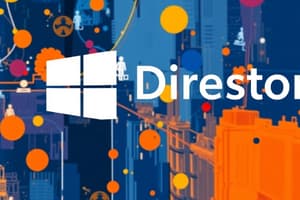Podcast
Questions and Answers
What is the primary purpose of Active Directory Domain Services (AD DS)?
What is the primary purpose of Active Directory Domain Services (AD DS)?
- Sets up firewall rules for secure connections
- Monitors hardware performance in the network
- Handles network traffic between devices
- Manages user access and stores directory data
Which component of Active Directory allows for better management of users and resources?
Which component of Active Directory allows for better management of users and resources?
- Organizational Units (OUs) (correct)
- Forest
- Domain Controller (correct)
- Access Control Lists (ACLs)
Which feature of Active Directory is used to implement specific configurations for users and computers?
Which feature of Active Directory is used to implement specific configurations for users and computers?
- LDAP
- Replication
- Group Policy (correct)
- Kerberos Authentication
What does the schema in Active Directory define?
What does the schema in Active Directory define?
Which protocol is primarily used for secure user authentication in Active Directory?
Which protocol is primarily used for secure user authentication in Active Directory?
Flashcards are hidden until you start studying
Study Notes
Overview of Active Directory
- A directory service developed by Microsoft for Windows domain networks.
- Centralizes network management, authentication, and resource allocation.
Key Components
-
Domain:
- A logical group of network objects (users, devices, etc.).
- Defines security policies and user rights.
-
Organizational Units (OUs):
- Sub-divisions within domains.
- Used for grouping users and resources for easier management.
-
Active Directory Domain Services (AD DS):
- Core service that stores directory data and manages user access to resources.
-
Domain Controllers (DC):
- Servers that authenticate users and manage domain security.
- Store a copy of the AD DS database.
-
Forest:
- A collection of one or more domains that share a common schema and configuration.
-
Tree:
- A hierarchy of one or more domains that share a contiguous namespace.
Functions of Active Directory
-
Authentication:
- Validates user credentials and manages logins.
-
Authorization:
- Determines user permissions to access resources.
-
Policy Enforcement:
- Applies Group Policies to manage user and computer environments.
-
Replication:
- Synchronizes directory changes across multiple domain controllers.
Key Concepts
-
Group Policy:
- A feature that allows administrators to implement specific configurations for users and computers.
-
LDAP (Lightweight Directory Access Protocol):
- Protocol used to access and maintain directory information services.
-
Trust Relationships:
- Links between different domains that allow users in one domain to access resources in another.
-
Schema:
- Defines the structure of data within the directory, including object types and attributes.
Security Features
-
Kerberos Authentication:
- Default authentication protocol used by AD for secure user authentication.
-
Access Control Lists (ACLs):
- Define permissions and rights for accessing objects within AD.
Management Tools
-
Active Directory Users and Computers (ADUC):
- GUI tool for managing AD objects.
-
Active Directory Administrative Center (ADAC):
- Enhanced management interface for AD.
-
Windows PowerShell:
- Command-line interface for scripting and automating AD management tasks.
Best Practices
- Regularly update and patch domain controllers.
- Implement a strong password policy.
- Use Group Policies for consistent security settings.
- Monitor and audit Active Directory for unauthorized access or changes.
Overview of Active Directory
- Developed by Microsoft for Windows domain networks, centralizing network management, authentication, and resource allocation.
Key Components
- Domain: Logical grouping of network objects (e.g., users, devices) that defines security policies and user rights.
- Organizational Units (OUs): Sub-divisions of domains used for easier management by grouping users and resources.
- Active Directory Domain Services (AD DS): Core service responsible for storing directory data and managing user access to resources.
- Domain Controllers (DC): Servers that authenticate users, manage domain security, and store a copy of the AD DS database.
- Forest: Collection of one or more domains sharing a common schema and configuration.
- Tree: Hierarchical structure of one or more domains that share a contiguous namespace.
Functions of Active Directory
- Authentication: Validates user credentials and manages login processes.
- Authorization: Determines user permissions for resource access.
- Policy Enforcement: Applies Group Policies to manage user and computer environments effectively.
- Replication: Synchronizes directory changes across multiple domain controllers to maintain consistency.
Key Concepts
- Group Policy: Allows administrators to enforce specific configurations for both users and computers.
- LDAP (Lightweight Directory Access Protocol): Protocol for accessing and maintaining directory information services.
- Trust Relationships: Links between different domains permit users in one domain to access resources in another.
- Schema: Defines the structure of directory data, including object types and their attributes.
Security Features
- Kerberos Authentication: Default protocol for secure user authentication within Active Directory.
- Access Control Lists (ACLs): Define permissions and rights for accessing various objects within Active Directory.
Management Tools
- Active Directory Users and Computers (ADUC): GUI tool for managing Active Directory objects.
- Active Directory Administrative Center (ADAC): Enhanced management interface for streamlined administration tasks.
- Windows PowerShell: Command-line interface for automating and scripting Active Directory management tasks.
Best Practices
- Regularly update and patch domain controllers to ensure security and performance.
- Implement a strong password policy to protect user accounts.
- Utilize Group Policies to maintain consistent security settings across the network.
- Monitor and audit Active Directory to detect unauthorized access or changes efficiently.
Studying That Suits You
Use AI to generate personalized quizzes and flashcards to suit your learning preferences.




